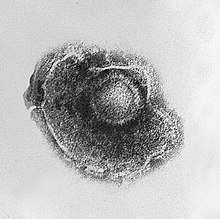Varicella zoster virus
| Varicella zoster virus | |
|---|---|
 |
|
| Electron Micrograph of VZV. | |
| Virus classification | |
| Group: | Group I (dsDNA) |
| Order: | Herpesvirales |
| Family: | Herpesviridae |
| Subfamily: | Alphaherpesvirinae |
| Genus: | Varicellovirus |
| Species: | Human herpesvirus 3 (HHV-3) |
| Synonyms | |
|
|
Varicella zoster virus (VZV) is one of eight herpesviruses known to infect humans. VZV infections are species-specific to humans. It causes chickenpox (varicella), a disease most commonly affecting children, teens and young adults and herpes zoster (shingles) in older adults; shingles is rare in children. VZV is known by many names, including chickenpox virus, varicella virus, zoster virus, and human herpesvirus type 3 (HHV-3).
VZV multiplies in the lungs, and causes a wide variety of symptoms. After the primary infection (chickenpox), the virus goes dormant in the nerves, including the cranial nerve ganglia, dorsal root ganglia, and autonomic ganglia. Many years after the patient has recovered from chickenpox, VZV can reactivate to cause neurologic conditions.
Primary varicella zoster virus infection results in chickenpox (varicella), which may result in complications including encephalitis, pneumonia (either direct viral pneumonia or secondary bacterial pneumonia), or bronchitis (either viral bronchitis or secondary bacterial bronchitis). Even when clinical symptoms of chickenpox have resolved, VZV remains dormant in the nervous system of the infected person (virus latency), in the trigeminal and dorsal root ganglia.
In about 10–20% of cases, VZV reactivates later in life, producing a disease known as shingles or herpes zoster. VZV can also infect the central nervous system, with a 2013 article reporting an incidence rate of 1.02 cases per 100,000 inhabitants in Switzerland, and an annual incidence rate of 1.8 cases per 100,000 inhabitants in Sweden.
Other serious complications of varicella zoster infection include postherpetic neuralgia, Mollaret's meningitis, zoster multiplex, and inflammation of arteries in the brain leading to stroke, myelitis, herpes ophthalmicus, or zoster sine herpete. In Ramsay Hunt syndrome, VZV affects the geniculate ganglion giving lesions that follow specific branches of the facial nerve. Symptoms may include painful blisters on the tongue and ear along with one sided facial weakness and hearing loss.
...
Wikipedia
